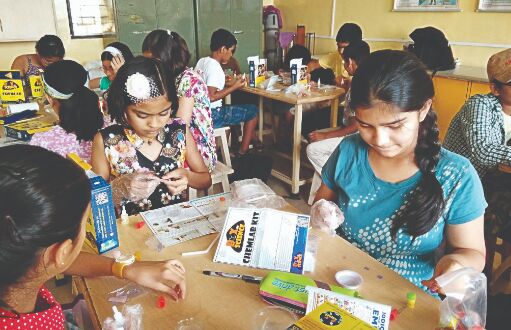Fostering curiosity
Teaching-learning horizon of chemistry needs to be expanded beyond theories

The importance of science and technology lessons in elementary education is widely acknowledged. The rapid changes in 21st-century society make considerable demands on human skills and adaptability. To be able to meet these requirements, children should be prepared to become active agents of their learning process from an early age. One of the goals of science education is to acquire sound conceptual knowledge about the world through the formulation of relationships. Chemistry is one of the most spectacular sciences in the world.
While studying chemistry from secondary level to postdoctoral research, I observed many striking reactions and transmutations. Initially, I did not love chemistry as its study started with theoretical rudiments. The dullness of the theory became quite comprehensible and interesting when I backed it with visual materials or real experiments. The major challenge that confronts chemistry education across the vertical curricular strata is the gap between the high requisite effort for learning chemistry and the low efforts that students make partially due to irrelevant teaching methods. Traditionally, chemistry curricula tend to prioritise the subject over its application. The relevance of teaching chemistry through the processes and products we utilize in society is ignored. Current curriculum approaches do not meet expected levels of conceptual relevance.
I could not ignore this important subject despite difficulties as I had a tremendous zeal to understand matter and energy and the way they interact with each other. Also, chemistry is everywhere around us. It is in the food and the water that we consume, the clothes we wear, our daily soaps and detergents, medicines, our body function, geochemical cycle and whatnot. It is often called the 'central science' as it connects physics, biology, geology and environmental science. Other than being important in our day-to-day life, having a good grip on chemistry is very important for competitive exams as it is one of the most scoring subjects.
Most instructors focus on helping students accumulate information about scientific ideas but do not foster the development of cognitive skills, nor do they help them learn real-life applications of the concepts. In my case too, I could not apply chemistry to everyday life events as there was no opportunity to do so. Such important methods should be incorporated into the lessons. Everyday life experiences are a way to make science meaningful to students. If we wish to educate and impart scientific temper in students, the most important task will be to provide an opportunity for understanding the underlying principles of chemistry and then applying this knowledge in day to day life. Learning chemistry will be fun if formal instructions follow the conception derived from a student's everyday life experiences. It is pertinent to mention that I was overwhelmed when I understood the science behind tears during cutting onion bulbs. It was followed by many more curious explorations. As per my experience, enquiry-based learning provides opportunities to engage students in scientific processes and invite them to use critical thinking skills as they search for answers.
Interesting facts not only involve the students in studying the topic further but also provide a fresh perspective to look at mundane things. In chemistry, we can find many of these curiosity-arousing facts. In addition to the understanding of the properties of substances, enquiry-based science lessons also help to explore the history of their discovery or study. For example, the origin of the name 'cobalt' has an interesting history. Some cobalt minerals are contained in arsenic compounds. When miners burnt this material, the gaseous arsenic oxide was released, causing poisoning among humans. As the toxicity of arsenic and its compounds were unknown at the time, it was thought that miners were killed by the pranks of the mountain spirit, the Kobold. In German, the word "Kobold" means "gnome".
Chemistry, as a subject, is infinitely intriguing and fascinating. It is not very popular among most students because of the so-called 'exceptions'. We must put together a list of things in students' studying habits so they can start enjoying chemistry. Against many interesting facts, students have misconceptions around a few complex topics.
My interaction with students attending the Rural Science Centre in my village substantiates this view. A group of students had misconceptions regarding the cause of plant growth. They believed the substance of the plant comes originally from organic compounds in the soil (besides water). By explaining the correct scientific ideas by presenting real plants from the garden and pictures, they understood the issue of absorbing minerals and water from the soil by the mechanism of photosynthesis.
Similarly, students confused the chemical change (burning) by physical change (melting) during the lighting of the candle. They believed that the candle lost its substance during melting. The practical demonstration showed them that melted material didn't equal the quantity of material that was lost from the lighted candle.
Chemistry is truly a fascinating science. Its theories must be backed by practical reactions, pictures and interesting facts to overcome the mental block and the initial resistance towards it.
The article aims to point out ways of effective educational approaches that can be implemented by chemistry instructors to make chemistry teaching realistic and easy to understand to motivate students' intellectual curiosity. It will enhance learning regardless of their career choices.
Views expressed are personal



